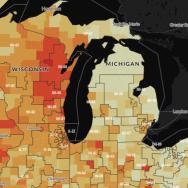When COVID-19 cases first broke out in the United States, nurses helped mitigate public health effects by moving to the areas of greatest need. As the pandemic worsens in the midst of the holiday season, concerns about nursing shortages have emerged across the country.
New research from the University of Chicago illuminates the economics of temporary nursing markets.
In a new working paper, Assoc. Prof. Joshua D. Gottlieb found the short-term labor market for nurses to be highly elastic during the early months of the pandemic. Because nurses were willing to accept jobs farther from home in exchange for higher pay, this elasticity helped hospitals in the U.S. adapt to increased demand for nursing in places where coronavirus cases surged during the spring and summer.
“At a time when many U.S. health care systems faced the risk of being overwhelmed,” Gottlieb said, “the willingness of nurses to move for increases in compensation—even at a time of great uncertainty—was important to the initial impact of the pandemic not being even more devastating.”
However, such movement may not be sufficient if there is simultaneous demand in many different markets—a situation we may face with the pandemic surging across the entire country.
“In this situation, reallocating workers to the highest-need places will likely prove insufficient, and the U.S. would require an increase in the total number of nurses,” said Gottlieb, a health care economist at the Harris School of Public Policy. “This requires national supply of nurses to expand through longer work hours, hiring nurses who normally work in less acute settings, or enticing trained nurses back into the labor force, or into nursing from other careers. All of these changes will likely require even higher compensation than we saw in the spring.”
In the paper, released by the Becker Friedman Institute for Economics, Gottlieb quantifies just how impactful nurses were in responding to the coronavirus pandemic this year. He co-authored the research with Avi Zenilman, a registered nurse and a doctoral candidate at Yale University.
Using data from a health care staffing firm, they found that job postings for temporary nurse positions tripled from their usual rate at the height of the pandemic’s first wave, and increased even faster in places facing extreme pandemic conditions. In New York state, for example, job postings increased eightfold, while compensation almost doubled.
The differences across states and across nursing specialties allowed Gottlieb and Zenilman to study workers’ flexibility in this market. They found that demand skyrocketed for nurses in intensive care units (ICU) and emergency rooms (ER). For these specialties, the number of job openings and compensation rates tended to increase according with state-level COVID-19 case counts.
“In other words, more COVID-19 patients implies increased need for traveling nurses, and higher payments required to recruit them,” Gottlieb explained. “This suggests that price signals are effective at reallocating nurses to the parts of the country with increased staffing needs. In fact, we find that that nurses who accept such postings travel longer distances from their homes to job locations when pay is higher.”
Gottlieb and Zenilman estimate that ICU jobs increased by 239% during the first wave of the pandemic, while compensation increased 50%. ER jobs increased by 89% while compensation increased by 27%. At the same time, they found little-to-no increase in wages for nurses working in labor and delivery units, as the first wave of the pandemic did not change the number of women who were already pregnant.
—This story was first published by the Harris School of Public Policy.

